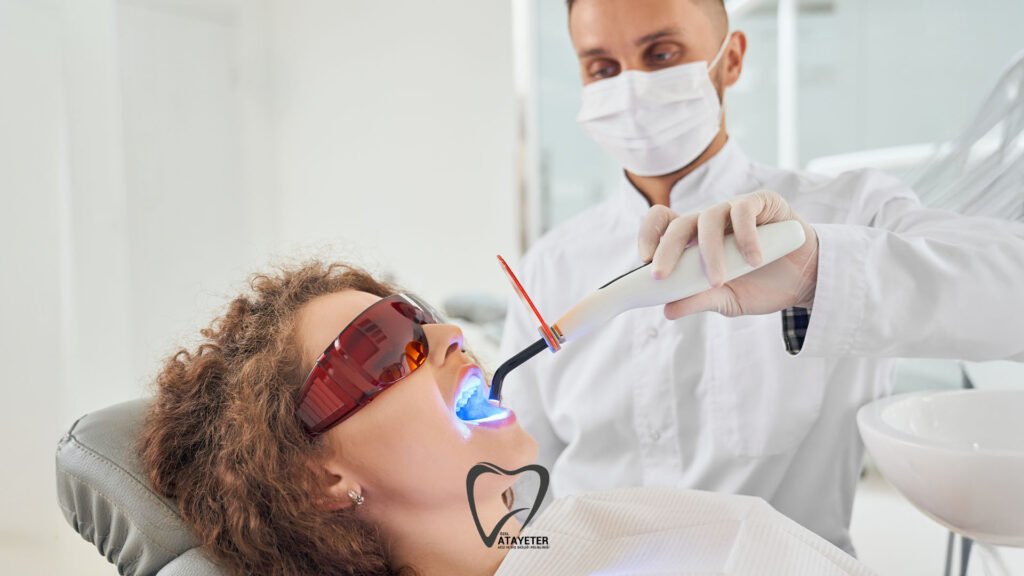A smile is one of the most striking first impressions a person makes on others. Healthy, straight teeth not only provide an aesthetically pleasing appearance but also significantly impact self-confidence and social interaction. However, over time, our daily habits and lifestyle can cause teeth to lose their natural whiteness. Habits such as coffee, tea, red wine, or smoking can cause stains on the surface of the teeth, while aging and certain foods can also change their color tone.
Whitening procedures performed using modern dentistry methods not only restore the natural whiteness of teeth but also provide individuals with a more aesthetically appealing smile. Furthermore, white and healthy-looking teeth boost self-confidence and enable more comfortable and effective social interactions. While teeth whitening may seem like a simple procedure, it’s an effective aesthetic procedure that can positively transform a person’s quality of life and self-expression.
What is Teeth Whitening?
Teeth whitening is an aesthetic dentistry procedure used to lighten teeth and remove stains that have accumulated over time. This method aims to reveal the natural whiteness of teeth without damaging the enamel, giving the person a more vibrant, healthy smile.
Teeth whitening is generally performed in two different ways. Office-based, or professional, whitening is performed by a dentist in a clinic and provides effective results in a short time. The other method is home whitening, where custom-designed tray and gel systems are applied at home under the supervision of a dentist. Both methods are safe; however, applications performed under professional supervision offer more permanent and visible results.
Why Do Our Teeth Change Color?
It’s quite common for teeth to become discolored or stained over time. The main causes of yellowing or discoloration are:
Food and Drinks: Coffee, tea, red wine, and colored sauces can affect the color of your teeth.
Cigarettes and Tobacco Products: Smoking causes teeth to yellow and stain.
Aging: Over time, tooth enamel becomes thinner and the underlying dentin layer becomes more visible. This can cause teeth to turn yellow.
Medication Use: Some antibiotics and medications, especially when used in childhood, can cause tooth discoloration.
Genetic Factors: The natural color of teeth can vary from person to person.

Teeth Whitening Methods
Office Whitening
This procedure, performed in a clinical setting, can usually be completed in a single visit. The dentist covers the gums with a special protective gel and then applies the whitening gel to the tooth surface. In some methods, the effectiveness of the procedure is enhanced by the use of light or laser. The biggest advantages of this method include its rapid results, its application under professional supervision, and its noticeable and long-lasting effects.
Home Whitening
This is a home-based method using custom trays and whitening gels prepared by a dentist. It typically takes several weeks. The advantages of this method include the ability to apply according to one’s own schedule, easier sensitivity control, and being particularly suitable for light stains.
Combined Whitening
In some cases, in-office whitening and at-home whitening can be combined. This approach is an ideal option for those who want both fast and permanent results.
Who Is Teeth Whitening Suitable For?
Teeth whitening is an aesthetic procedure that can generally be safely performed on individuals with healthy teeth and gums. However, in some cases, additional treatments may be required before the procedure. For example, individuals with tooth decay or gum problems should address these issues first. Similarly, if your teeth are extremely sensitive, cracked, or chipped, it’s important to address these issues before starting the whitening process. Furthermore, some whitening methods are not recommended for pregnant or breastfeeding individuals.
Therefore, it’s most reliable and healthy for anyone considering teeth whitening to first have a professional evaluation by a dentist. This way, both effective and safe results can be achieved.

Things to Consider After Teeth Whitening
After teeth whitening, it’s important to take certain precautions to maintain the white and bright appearance and minimize any potential sensitivity. Avoiding coffee, tea, red wine, and dark-colored foods for the first 48 hours after the procedure will help prevent re-staining. Smoking can also negatively impact tooth color, so if possible, avoid smoking after the procedure.
If you experience sensitivity, using desensitizing toothpaste recommended by your dentist can provide relief. Additionally, regular brushing and flossing should be a priority; this will help maintain the health of your teeth and ensure long-lasting whiteness. It’s also helpful to see your dentist for periodic checkups and touch-ups when necessary to maintain the whitening effect.
Side Effects and Cautions
Teeth whitening is generally safe, but some people may experience temporary sensitivity and mild gum irritation. These side effects usually subside quickly and are not serious. These risks can be minimized with professional supervision and correct application.

Teeth Whitening Prices
Teeth whitening is one of the most preferred aesthetic procedures for a healthy and bright smile, and prices can vary depending on the type of procedure, the condition of the teeth, and individual needs. Because professional in-office whitening and at-home, dentist-supervised methods require different processes, costs are also determined accordingly. Factors such as the intensity of tooth staining, sensitivity, the number of sessions required, and the experience of the clinic and dentist also affect the price.Therefore, when deciding on teeth whitening, it’s important to consider not only the price but also the safe and healthy method.
For accurate information, it’s essential to consult a dentist.Atayeter Oral and Dental Health Polyclinic









